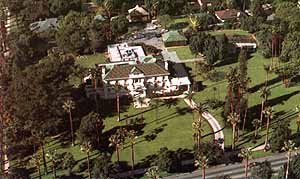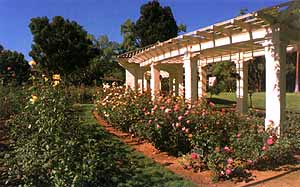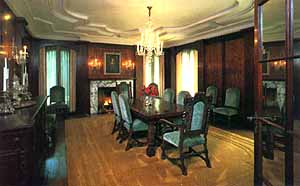
By Judy O'Sullivan
The palatial edifice of Tournament House looks familiar to TV viewers around the world. Network "establishing shots" show the three-story structure close-up. Zoom back until the cream-colored building stands proudly like a gracefully aging dowager wrapped in a sweeping four and a half acre lawn-skirt embroidered with a fussy-white arbor and rose gardens--boasting 100 varieties.
Early New Year's morning the Rose Court, American beauties themselves, make their entrance through the front door, cradling bouquets of locally grown roses, waving to the cameras. Slowly, they cross the columned porch and descend the gleaming marble steps, gliding across the walkway to the waiting floral coach known internationally as "The Queen's Float."
When the network cameras stop rolling and the million spectators who've come to see the Rose Parade "live" depart, this headquarters of The Tournament of Roses Association goes back to the hum-drum of everyday work. What happens at 391 So. Orange Grove Blvd. in Pasadena, California, in this ultra-fancy building after the ball is over so to speak? Yet another parade and game are painstakingly produced.

For a complete walking tour and map of the grounds, click here.
Originally built for the Stimson family, the geometric white structure exudes classic Mission Revival-style--with touches of Beaux Arts grandeur. Some describe it as Italian Renaissance. Either way, the 22-room manse would fit right in on the Gold Coast or the Riviera. G. Lawrence Stimson, the architect-owner, intended as much when he drew up the blue prints in 1906 and hired his father George to do the construction. It took eight years to complete inside and out what with ordering Circassian walnut for walls and the imported crystal chandeliers. Upon completion, plans changed as plans often do, and rather than move in the younger Stimsons put their dream house on the market. Asking price: $170,000.
Looking for a way to escape Chicago blizzards three months of the year, William Wrigley, Jr, and his wife put up at a local hotel for a month in December of 1914 and went house hunting. Not much was for sale. They bought the "modest" Stimson home and started making changes.
Mrs. Wrigley hired LeRoy D. Ely to decorate the interior space with comfortable furnishings--long couches and easy chairs. Meanwhile, her husband acquired the vacant lot next door for $25,000. He told their English gardener to put in, what else? An English rose garden--a virtual sea of blossoms cresting in pastel waves of color. The same gardener transplanted specimen trees from around the world on the wide-open acreage. For years, palms (gone now) guarded the perimeter like tall, thin sentries wearing feathered hats. Because of the encroaching forest that blocked the morning sun Wrigley christened his estate: The Shadows.

Hand-carved dining room furniture from Italy ordered for the Santa Catalina address couldn't survive the sea air. It was relegated to the Orange Grove dwelling early on. Some of the rooms were quickly redecorated. Others continued to reveal traces of a by-gone era: dark water marks, faded wallpaper. The association added offices for 12 paid staff at the rear of the main house and completed extensive remodeling and expansion in 1988 with special attention given to the Queen's upstairs Powder Room.
On Thursday afternoons from February through August, Tournament House is open to the public and guided tours of the facilities are conducted by docents from 2 to 4 p.m.
Call it what you will, Tournament House or Wrigley House, it's a marvelous magical place, a true factory producing among other things Cinderella dreams.